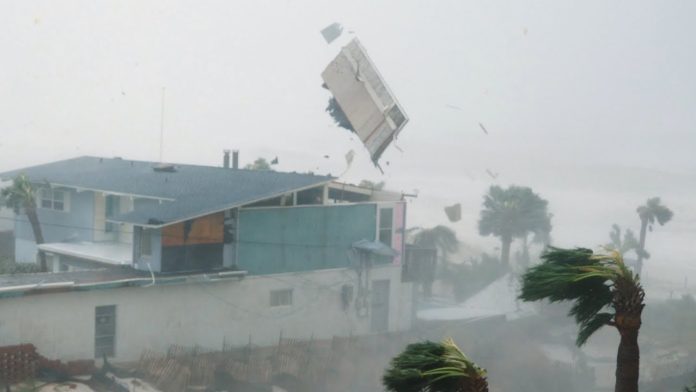Hurricane Ian is expected to make landfall in Florida Wednesday, bringing “catastrophic storm surges,” winds, and flooding to the coast areas it passes.
Residents were prepared for a very dangerous storm that battered Cuba and could strike the Florida peninsula as one the most powerful hurricanes to hit the United States in many years.
According to the National Hurricane Center & news busters, Ian reached maximum sustained winds at 155 miles an hour. This makes it a powerful category 4 hurricane, just a few inches shy of category 5.
What do meteorologists and news anchors really mean when they talk of hurricane categories like category 1 or category 3?
People simply want to know how much wind and water they can expect and what a hurricane means for their safety. Although hurricane categories are not able to predict every aspect of a storm’s path, they can give an indication as to how it will affect property and people.
Here are the basics of hurricane categories.
From where do the hurricane categories originate?
Hurricanes are measured using the Saffir-Simpson Hurricane Wind Scale. It ranges from Category 1 to Category 5. According to The Weather Channel the scale was created by Herbert Saffir, a Miami engineer, and Robert Simpson (a meteorologist who was the director of the National Hurricane Center).
Although the hurricane category scale has changed over time, its current version only measures wind speeds caused by hurricanes. The different hurricane category designations don’t give any information about flooding or tornadoes that could accompany hurricanes. However, they can help you get a feel for how strong a hurricane might have and what type of threat they might pose.
Category 1 hurricane: Extremely dangerous winds can cause some damage
Winds can reach speeds of 74-95 mph in a Category 1 Hurricane. People, animals, and pets could be harmed by falling debris, while older mobile homes may be damaged. Glass windows with protective glass will usually survive the hurricane without any major damage. Frame homes, apartments, and shopping centers could be damaged, and snapped power lines may cause short-term power outages.
Hurricane Dolly, a Category 1 hurricane that battered southern Texas in 2008, was an example. Hurricane Sandy, which hit Jamaica in 2012 as a Category 1 hurricane, was weakened before it reached the east coast of America.
Category 2 hurricane: Extremely dangerous winds can cause severe damage
Category 2 hurricanes can bring winds between 96 and 110 mph. Flying debris poses a greater risk to pets, livestock, and people. Mobile homes older than 10 years old will be likely to be destroyed. Debris can also cause damage to newer homes. Shop centers, frame homes, and apartment buildings may suffer significant roof and siding damage. Many trees could also be felled. After a Category 2 hurricane, residents should expect to experience near total power outages. Outages can last anywhere from a few days up to several weeks.
Hurricane Frances was a Category 2 hurricane that struck the west coast Florida in 2004.
Category 3 hurricane: The destruction of lives and property will be devastating
Wind speeds can reach speeds of 111 to 129 mph in a Category 3 Hurricane. People, livestock, and pets are at high risk for injury or death from falling debris and flying debris. Most mobile homes older than 10 years old will be destroyed. Newer homes will suffer significant damage. Even the best-built frames homes, apartments, and industrial buildings may suffer major damage. Additionally, many trees could be uprooted by the storm, which could cause roadblocks. Water and electricity will be out of service for several days or weeks following the storm.
Hurricane Wilma, which brought winds up to 120 mph, was a Category 3 hurricane that struck Florida’s coast in 2005. Hurricane Katrina, a Category 3 hurricane, made landfall in Louisiana in 2005. However, it brought with it high levels of storm surge which the levees of Louisiana and New Orleans could not withstand. This is what made it so devastating.
Hurricane Irma, which made landfall in the Atlantic as a Category 3 hurricane before it became a Category 5, was the second-strongest Atlantic hurricane ever recorded.
Catastrophic flooding will be caused by Category 4 hurricane
The winds can reach speeds of 130-156 mph during a Category 4 hurricane. These speeds pose a high risk of injury and death for livestock, pets, and people. Even newer mobile homes can be destroyed. Frame homes can collapse completely, but well-built homes are more likely to sustain severe roof damage. Apartment buildings may also be damaged on the upper floors.
Category 4 Hurricane
A Category 4 hurricane can blow out windows in high-rise buildings, cause tree and power line damage, and uproot most trees. After storms of this magnitude, power outages can last weeks or even months. In the aftermath of Category 4 hurricanes water shortages can also be common, making it impossible for affected areas to live for several weeks or even months.
In August, Hurricane Harvey struck Texas as a Category 4 hurricane.
Catastrophic destruction will be caused by Category 5 Hurricane
Category 5 hurricanes are the strongest category hurricanes. Winds reach 157 mph and higher in a Category 5. Flying debris can pose a danger to pets, livestock, and people even indoors. Mobile homes and frames homes will most likely be destroyed. Wooden roof commercial buildings will suffer severe damage. Metal buildings could collapse, and high-rise windows may be nearly destroyed.


